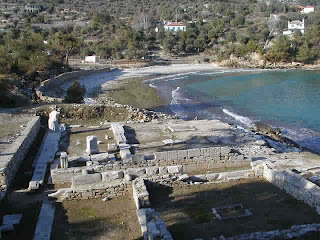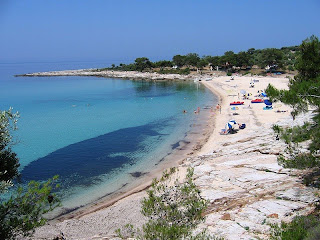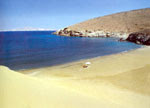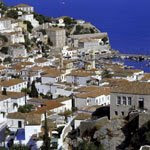
Path with stairs to the Palataki
 Path in the shade of pine trees.
Path in the shade of pine trees.Limenaria again...
View at Metalia beach and old mine.
Metalia beach between funels.
The only bar on the beach.

 Path in the shade of pine trees.
Path in the shade of pine trees.

 Santorini is after Vesuvius one of the most and best studied volcanoes as very seldom in the construction of a complex a volcano appears so clearly. A tragic irony in the geophysical history of Santorini is that the great destruction, lost in the centuries speeds today its incomparable beauty everywhere. To get aware of it one has to tour the caldera from which he will see its deep blue waters and in a height 200-300 meters the dark colored walls of caldera. The different colors of volcanic sand and different kinds of lava are very distinct because of their colors which vary from red to braon and black.
Santorini is after Vesuvius one of the most and best studied volcanoes as very seldom in the construction of a complex a volcano appears so clearly. A tragic irony in the geophysical history of Santorini is that the great destruction, lost in the centuries speeds today its incomparable beauty everywhere. To get aware of it one has to tour the caldera from which he will see its deep blue waters and in a height 200-300 meters the dark colored walls of caldera. The different colors of volcanic sand and different kinds of lava are very distinct because of their colors which vary from red to braon and black. The main characteristic of Santorini's architecture is the "dug-in buildings", buildings that are constructed into the tephran earth, the tephra. The typical "dug-in house" is characterized by a narrow facade and is very deep lengthwise. At the front of the house we find the living room and at the back, the bedroom.
The main characteristic of Santorini's architecture is the "dug-in buildings", buildings that are constructed into the tephran earth, the tephra. The typical "dug-in house" is characterized by a narrow facade and is very deep lengthwise. At the front of the house we find the living room and at the back, the bedroom. 
 The ground in Santorini, as well as the ground of the most Cyclades islands is rocky.
The ground in Santorini, as well as the ground of the most Cyclades islands is rocky. Arid Tomatoes, cherry tomatoes of Santorini is a special agricultural product with great history. tomato is a characteristic products of Santorini and has a factory pelte cooperative of Santorini, which gives hope for the future. From tomato besides pelte made pentanostimes fresh salads, but also its famous tomato-balls (tomatokeftedes).
Arid Tomatoes, cherry tomatoes of Santorini is a special agricultural product with great history. tomato is a characteristic products of Santorini and has a factory pelte cooperative of Santorini, which gives hope for the future. From tomato besides pelte made pentanostimes fresh salads, but also its famous tomato-balls (tomatokeftedes). Sprit Peas (Fava) -the Fava of Santorini is the most important products of the island.
Sprit Peas (Fava) -the Fava of Santorini is the most important products of the island. 1. Alyki beach itself is quite picturesque-the beach is very popular and therefore does get pretty busy. Two small white-sand beaches, calm seas with soft sand in and out of the water, a tradition village, the ancient marble quarries, pine trees, fishing. Here we have a beautiful little beach of which I thought it was only possible to be seen on paintings. Alyki is the site of a great archaeological interest, with many ancient and medieval monuments. Right behind the shacks that stand of the beach today there was once a significant ancient settlement. In its heyday, the settlements was very prosperous, evidence of which can be seen in the surviving monuments.
1. Alyki beach itself is quite picturesque-the beach is very popular and therefore does get pretty busy. Two small white-sand beaches, calm seas with soft sand in and out of the water, a tradition village, the ancient marble quarries, pine trees, fishing. Here we have a beautiful little beach of which I thought it was only possible to be seen on paintings. Alyki is the site of a great archaeological interest, with many ancient and medieval monuments. Right behind the shacks that stand of the beach today there was once a significant ancient settlement. In its heyday, the settlements was very prosperous, evidence of which can be seen in the surviving monuments. 
 2. Psili Ammos is a tourist resort about 5 minutes south-east from Potos. The beach is about 250m long. It is one of the most beautiful beaches on the island. It is the ideal place for water sports.
2. Psili Ammos is a tourist resort about 5 minutes south-east from Potos. The beach is about 250m long. It is one of the most beautiful beaches on the island. It is the ideal place for water sports.
 3. Pachis is beautiful beach just north of Skala Rachoni. There is a long stretch of golden sand backed by tamarack trees with plenty of parking beneath the trees. There are a couple of large tavernas set back from the beach and some smaller ones on the beach itself.
3. Pachis is beautiful beach just north of Skala Rachoni. There is a long stretch of golden sand backed by tamarack trees with plenty of parking beneath the trees. There are a couple of large tavernas set back from the beach and some smaller ones on the beach itself.

 4.Trypity lies to the west of Limenaria, abut 5 minutes put of town and is well marked from the main road. A long dirt track runs behind the beach for much of its length and there are beach bars at either and serving basic snacks and drinks. Cars can be parked under the trees at either end of the long track near to the beach bars.
4.Trypity lies to the west of Limenaria, abut 5 minutes put of town and is well marked from the main road. A long dirt track runs behind the beach for much of its length and there are beach bars at either and serving basic snacks and drinks. Cars can be parked under the trees at either end of the long track near to the beach bars. 
.jpg) 5.Metalia, beautiful beach in Limenaria.
5.Metalia, beautiful beach in Limenaria.

 6. Pefkari, Paddle boats, surfboards and jet skies prominently parked on the manicured white sand-clues, if you needed them, to the popularity of the fine beach. Gently shelving sand and shallow water make this an ideal spot for children and the nearby headland offers plenty of splendid cliff side walks.
6. Pefkari, Paddle boats, surfboards and jet skies prominently parked on the manicured white sand-clues, if you needed them, to the popularity of the fine beach. Gently shelving sand and shallow water make this an ideal spot for children and the nearby headland offers plenty of splendid cliff side walks. 7. Marble beach is one beautiful small beach with white send and blue water. This is fantastic and quite place with very clean water.
7. Marble beach is one beautiful small beach with white send and blue water. This is fantastic and quite place with very clean water. 
.jpg)
 8. Makryammos is a very pretty beach with clear waters in a picturesque bay bordered by pine trees to the east of the town of Limenas. The beach is sandy, with organised facilities ideal for endless hours of sunbathing. To the right of the beach is wharf , a shelter for small boats and pleasure craft. Right opposite, on the other side of the bay, is small, pine-clad rock adding to the beauty of surroundings.
8. Makryammos is a very pretty beach with clear waters in a picturesque bay bordered by pine trees to the east of the town of Limenas. The beach is sandy, with organised facilities ideal for endless hours of sunbathing. To the right of the beach is wharf , a shelter for small boats and pleasure craft. Right opposite, on the other side of the bay, is small, pine-clad rock adding to the beauty of surroundings. 9. few kilometres down from Panagia is one of the island's the best known beaches. Golden beach appears to be truly endless golden beach with sand which leaves the first-time visitor the speechless. There are pine trees along the 3,5km bay and lodgings for tourists.
9. few kilometres down from Panagia is one of the island's the best known beaches. Golden beach appears to be truly endless golden beach with sand which leaves the first-time visitor the speechless. There are pine trees along the 3,5km bay and lodgings for tourists. 
 Golden beach organised facilities for those who enjoy water sports and long hours of sunbathing. On of the most beautiful spots on this beach from which you can admire its entire expanse, is Vigli, a densely forested place above the beach where a picturesque taverna is situated, surrounded by cool greenery.
Golden beach organised facilities for those who enjoy water sports and long hours of sunbathing. On of the most beautiful spots on this beach from which you can admire its entire expanse, is Vigli, a densely forested place above the beach where a picturesque taverna is situated, surrounded by cool greenery. 10. Paradise beach is one of the favorite tourist spots, is by by road that winds its way through a wooded area. The beach is not particularly long, but the forest around it and the fact that the sea is almost always pounding in with big breakers, make it reminiscent on an exotic tropical isle. The water is transparent green and certain points amond the rocks often provide a retreat for nudists. The small forest directly above the beach is ideal for camping and is full of caravans and tents throughout the summer.
10. Paradise beach is one of the favorite tourist spots, is by by road that winds its way through a wooded area. The beach is not particularly long, but the forest around it and the fact that the sea is almost always pounding in with big breakers, make it reminiscent on an exotic tropical isle. The water is transparent green and certain points amond the rocks often provide a retreat for nudists. The small forest directly above the beach is ideal for camping and is full of caravans and tents throughout the summer.
 Greece is a country that has much to offer to the visitors: paradisiacal landscapes, hundreds of charming islands, amazing sandy beaches in crystal waters, a passionate history…
Greece is a country that has much to offer to the visitors: paradisiacal landscapes, hundreds of charming islands, amazing sandy beaches in crystal waters, a passionate history…
 In 2006, 404 beaches and 5 marinas in Greece were awarded the “Blue Flag” (See below), a figure that places the country in a top-ranking position among other European countries.
In 2006, 404 beaches and 5 marinas in Greece were awarded the “Blue Flag” (See below), a figure that places the country in a top-ranking position among other European countries. The majority of the thousands of Greek coasts are freely accessible and you have the opportunity to discover and enjoy them without the presence of a large number of swimmers. There are also many organised beaches in the country.
The majority of the thousands of Greek coasts are freely accessible and you have the opportunity to discover and enjoy them without the presence of a large number of swimmers. There are also many organised beaches in the country. The criteria for the award of the “Blue Flag” are the following:
The criteria for the award of the “Blue Flag” are the following: The islands are Greece’s chief morphological trait and an integral part of the country’s civilisation and tradition. The Greek territory comprises 6,000 islands and islets scattered in the Aegean and Ionian Sea, a truly unique phenomenon on the European continent; of these islands only 227 are inhabited.
The islands are Greece’s chief morphological trait and an integral part of the country’s civilisation and tradition. The Greek territory comprises 6,000 islands and islets scattered in the Aegean and Ionian Sea, a truly unique phenomenon on the European continent; of these islands only 227 are inhabited. Most islands lie in the Aegean Sea and are divided in seven groups (from north to south):
Most islands lie in the Aegean Sea and are divided in seven groups (from north to south): The wealth and diversity of the Greek seas, the endless kilometres of the Greek coast and the thousands of Greek islands, the protected sea areas covering thousands of square kilometres, the mild climate, the high percentage of sunshine and its interesting and varying landscape make Greece the ideal destination for the development of sea tourism activities. This advantage is strengthened both by thousands of years of marine tradition and by conditions favourable for sea travelling: the Greek seas are considered safe, distances between coasts are small, while conditions related to wind strength, ambient and sea temperatures are equally favourable.
The wealth and diversity of the Greek seas, the endless kilometres of the Greek coast and the thousands of Greek islands, the protected sea areas covering thousands of square kilometres, the mild climate, the high percentage of sunshine and its interesting and varying landscape make Greece the ideal destination for the development of sea tourism activities. This advantage is strengthened both by thousands of years of marine tradition and by conditions favourable for sea travelling: the Greek seas are considered safe, distances between coasts are small, while conditions related to wind strength, ambient and sea temperatures are equally favourable. Greece is above all a mountainous country, as it is occupied by more than 300 rocky masses varying in elevation.
Greece is above all a mountainous country, as it is occupied by more than 300 rocky masses varying in elevation. In Greece you must visit archaeological sites, museums and monuments all over the country offers a vivid picture of the civilisations in Greece, their achievements in arts and technology from the pre-historic era to modern times.
In Greece you must visit archaeological sites, museums and monuments all over the country offers a vivid picture of the civilisations in Greece, their achievements in arts and technology from the pre-historic era to modern times. The unique tastes of Greece guarantee that you are in for many culinary surprises during your stay in the country. Contrary to common belief, you will discover that Greek cuisine is not only moussaka, souvlaki and choriatiki salata, but has a wide variety of dishes that can meet the culinary demands of both meat-eaters and vegetarians in an extremely satisfying way. Things could not be different, anyway, in the country that gave birth to symposiums and the Epicurean philosophers. It was, in fact, Archestratos who, in 330 B.C., wrote the first cookbook in History, and reminded us that cuisine is a sign of civilisation.Greece has a culinary tradition of approximately 4,000 years. Nevertheless, like most national cuisines, Greek cuisine has both influenced others and embraced ideas from its eastern and western neighbours.
The unique tastes of Greece guarantee that you are in for many culinary surprises during your stay in the country. Contrary to common belief, you will discover that Greek cuisine is not only moussaka, souvlaki and choriatiki salata, but has a wide variety of dishes that can meet the culinary demands of both meat-eaters and vegetarians in an extremely satisfying way. Things could not be different, anyway, in the country that gave birth to symposiums and the Epicurean philosophers. It was, in fact, Archestratos who, in 330 B.C., wrote the first cookbook in History, and reminded us that cuisine is a sign of civilisation.Greece has a culinary tradition of approximately 4,000 years. Nevertheless, like most national cuisines, Greek cuisine has both influenced others and embraced ideas from its eastern and western neighbours.